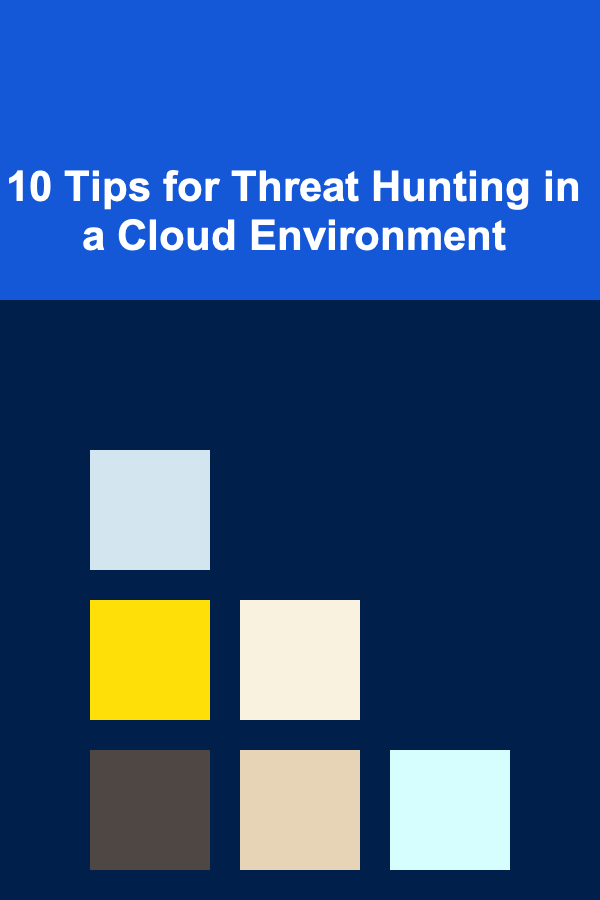
10 Tips for Threat Hunting in a Cloud Environment
ebook include PDF & Audio bundle (Micro Guide)
$12.99$11.99
Limited Time Offer! Order within the next:

Threat hunting is an essential part of modern cybersecurity, especially in cloud environments where traditional security measures may not be as effective. The shift to cloud-based infrastructures, such as public clouds, hybrid environments, and private clouds, has introduced new vulnerabilities and attack vectors that demand a proactive, investigative approach to identify and mitigate potential threats. In a cloud environment, threat hunting is not just about reacting to alerts; it involves actively searching for anomalies, uncovering hidden threats, and improving the overall security posture of the organization.
This article will cover 10 crucial tips for threat hunting in a cloud environment, providing cybersecurity professionals with actionable strategies to enhance their threat detection capabilities in the ever-evolving landscape of cloud security.
Understand Your Cloud Environment and Its Architecture
The first step in threat hunting within a cloud environment is having a thorough understanding of your cloud architecture. Cloud environments are complex, with a mix of on-premise systems, third-party applications, and cloud service providers (CSPs) involved. It's essential to understand the following key elements:
- Cloud service model (IaaS, PaaS, SaaS): Different service models offer varying levels of control over the environment, and understanding where responsibilities lie (e.g., who manages security in IaaS versus SaaS) is critical.
- Deployment model (public, private, hybrid): Different deployment models come with distinct security implications, such as data isolation, access controls, and external exposure.
- Cloud assets and resources: These include virtual machines (VMs), containers, network configurations, and storage. Having a map of these assets will help you detect deviations from the norm.
By comprehensively understanding your cloud infrastructure, you can more effectively identify abnormal behavior that could be indicative of a security threat.
Leverage Cloud-Native Security Tools
Cloud service providers (CSPs) typically offer native security tools and services that can greatly aid in threat hunting. These tools are designed to integrate directly with the cloud environment, providing insights and controls that are tailored to the platform.
Examples of Cloud-Native Security Tools:
- Amazon Web Services (AWS) CloudTrail and GuardDuty: AWS CloudTrail provides detailed logs of API calls, which are crucial for understanding who is doing what within your environment. AWS GuardDuty can help detect malicious activity by analyzing logs, network traffic, and resource usage.
- Microsoft Azure Security Center and Sentinel: Azure Security Center offers vulnerability management, compliance monitoring, and threat detection, while Azure Sentinel is a cloud-native SIEM (Security Information and Event Management) solution for intelligent threat detection.
- Google Cloud Security Command Center: This tool provides visibility into your Google Cloud environment, offering insights into potential misconfigurations, vulnerabilities, and anomalous behaviors.
Leveraging these tools can provide you with real-time insights, enabling faster identification and response to potential threats.
Monitor Cloud-Specific Logs and Metrics
One of the most powerful sources of information for threat hunters is the logs and metrics generated by cloud platforms. In cloud environments, logs provide a window into user activity, resource access, and system behavior. These logs can reveal suspicious activity that may otherwise go unnoticed.
- Audit logs: Most CSPs provide audit logs that track user and service actions. For example, AWS CloudTrail tracks API requests and records who initiated an action, the time of the request, and the source IP address.
- Network logs: These logs can help you identify unusual network traffic patterns, such as spikes in traffic or connections from unusual geographic locations.
- CloudWatch/CloudTrail for AWS: By integrating monitoring and logging into your cloud environment, AWS provides real-time insights that can be used to detect abnormal access patterns and potential data exfiltration.
Regular monitoring of these logs, with a focus on unusual access patterns, unauthorized access, and service misconfigurations, is key to effective threat hunting.
Implement a Baseline for Normal Activity
Effective threat hunting relies on the ability to differentiate between normal and abnormal behavior. This is particularly challenging in the cloud, where workloads are often dynamic, and users are distributed. Establishing a baseline for normal activity can help identify deviations that may signal a security incident.
Steps to Create a Baseline:
- User behavior analytics (UBA): Track and analyze user behavior to determine what normal activity looks like in your environment. UBA tools can automatically identify anomalies in user behavior that could indicate a compromised account.
- Application and service performance: Monitor typical application performance and resource consumption. A sudden spike in CPU usage or disk I/O could be an indicator of a security issue.
- Traffic patterns: Keep track of regular network traffic patterns, such as typical IP addresses or geolocations. Unusual spikes in traffic or unexpected locations should raise flags.
With a clear understanding of what "normal" looks like, threat hunters can focus their efforts on deviations that could indicate an attack or compromise.
Search for Misconfigurations and Vulnerabilities
Misconfigurations are one of the most common causes of cloud security incidents. Cloud services are often configured with default settings, which may not be optimal for security. Attackers frequently exploit these misconfigurations to gain unauthorized access or escalate privileges.
Areas to Check for Misconfigurations:
- Access controls and permissions: Ensure that identity and access management (IAM) policies are properly configured to restrict access to sensitive resources. Overly permissive settings, such as wide-open security groups or excessive user privileges, should be corrected.
- Storage buckets: Unsecured cloud storage buckets (such as S3 in AWS or Blob Storage in Azure) can be a prime target for attackers. Regularly check for publicly exposed buckets or those with weak access controls.
- Networking: Review network security settings, including firewalls, VPC configurations, and security group rules. Misconfigured network rules can expose resources to the internet or allow lateral movement within the network.
Hunting for misconfigurations should be part of an ongoing cloud security assessment process. Automated tools that scan for misconfigurations, such as AWS Config or Azure Policy, can aid in this process.
Use Threat Intelligence Feeds
Integrating threat intelligence feeds into your cloud environment is a crucial part of proactive threat hunting. Threat intelligence provides valuable context about emerging threats, known attack techniques, and malicious IP addresses. It allows you to correlate activity in your cloud environment with real-world data on threats.
Threat intelligence feeds can provide:
- Indicators of compromise (IOCs): Such as malicious IP addresses, URLs, and file hashes that are associated with known attacks.
- Tactics, techniques, and procedures (TTPs): These describe the behavior and methods of attackers, helping you recognize potential threats even if you have not encountered them before.
- Real-time alerts: You can integrate these feeds with your SIEM or monitoring systems to receive real-time alerts when a known threat is detected in your environment.
Threat Intelligence Sources:
- Commercial feeds: From providers like FireEye, CrowdStrike, or Anomali.
- Open-source feeds: Platforms like MISP (Malware Information Sharing Platform) or OpenDXL.
Integrating threat intelligence can greatly enhance your threat hunting efforts by providing you with actionable insights and helping you stay ahead of evolving threats.
Hunt for Insider Threats
Insider threats remain a significant concern in cloud environments, where employees, contractors, or third-party vendors with legitimate access may intentionally or unintentionally cause harm. Cloud platforms make it easier for users to access data remotely, which increases the risk of both malicious and unintentional insider threats.
How to Hunt for Insider Threats:
- Monitor privileged accounts: Track actions taken by privileged accounts, such as administrators or root users. These accounts have significant access to sensitive resources and should be regularly monitored for unusual activity.
- Behavioral anomalies: Look for signs of abnormal user behavior, such as accessing resources at odd hours, downloading large amounts of data, or performing tasks they don't typically engage in.
- Data exfiltration: Set up alerts for large-scale data transfers or abnormal access to sensitive data. Insider threats often manifest as data being accessed or transferred without a clear reason.
Leveraging user behavior analytics (UBA) and monitoring privileged access can help identify potential insider threats before they escalate.
Implement Automation for Repetitive Threat Hunting Tasks
Cloud environments are vast, and manual threat hunting can quickly become overwhelming, especially with large volumes of data. Implementing automation for repetitive tasks can free up valuable time for more in-depth investigations.
How to Use Automation:
- Automated scanning tools: Use automated tools to scan for vulnerabilities, misconfigurations, or malware in cloud resources.
- SIEM integration: Set up automated rules within your SIEM platform to detect and alert on known attack patterns, misconfigurations, or suspicious behavior.
- Incident response automation: For common threats, automate the response process. For example, automatically isolating an infected virtual machine or blocking malicious IP addresses.
By automating repetitive tasks, you can focus your efforts on more complex threat analysis, improving your overall efficiency and effectiveness in threat hunting.
Collaborate with Other Teams and Departments
Threat hunting in a cloud environment isn't a task that should be handled by the security team alone. Collaboration across departments and teams can provide additional insights into potential threats and create a more comprehensive security posture.
Teams to Collaborate With:
- DevOps: Work with your DevOps teams to understand the deployment pipeline and identify any risks associated with application or infrastructure changes.
- Network Operations: Collaborate with network teams to track abnormal traffic patterns or potential denial-of-service (DoS) attacks targeting cloud resources.
- Compliance teams: Ensure that your threat hunting efforts align with industry standards and regulations, such as GDPR, HIPAA, or PCI-DSS.
A coordinated, cross-functional approach enhances your ability to identify and mitigate threats early.
Stay Up to Date with Evolving Threats
Cloud environments are constantly evolving, and so are the tactics, techniques, and procedures (TTPs) used by attackers. As a threat hunter, it's crucial to stay up to date with the latest security research, attack trends, and cloud-specific threats.
Ways to Stay Informed:
- Security blogs and newsletters: Follow blogs like the AWS Security Blog, Microsoft Azure Security Blog, or Google Cloud Blog for updates on new cloud vulnerabilities and attack techniques.
- Security conferences: Attend conferences like Black Hat, DEF CON, and RSA Conference to learn about the latest cloud security trends and emerging threats.
- Threat intelligence sharing: Join information-sharing communities like ISACs (Information Sharing and Analysis Centers) or Threat Intelligence Platforms (TIPs) to stay informed about real-time threats.
Ongoing education and awareness are crucial in staying ahead of evolving cyber threats.
Conclusion
Threat hunting in a cloud environment is a dynamic and critical task that requires a proactive and well-planned approach. By understanding your cloud architecture, leveraging cloud-native tools, monitoring logs, searching for misconfigurations, and utilizing threat intelligence, you can significantly enhance your organization's ability to detect and mitigate threats. Cloud environments present unique challenges, but with the right strategies and continuous vigilance, you can stay ahead of attackers and protect your assets from evolving threats.
Reading More From Our Other Websites
- [Home Soundproofing 101] How to Soundproof a Hollow Core Door: Budget-Friendly Methods for Noise Control
- [Home Budget Decorating 101] How to Transform Your Kitchen with Budget-Friendly Updates
- [Personal Financial Planning 101] How to Invest in Real Estate on a Budget
- [Home Holiday Decoration 101] How to Create a Farmhouse Christmas Decor Using Recycled Materials
- [Rock Climbing Tip 101] Mastering the Art of Safe Falling: Essential Techniques for Everyone
- [Trail Running Tip 101] Conquering the Peaks: How to Prepare for a 50-Mile Trail Running Challenge
- [Home Rental Property 101] How to Improve Tenant Retention in Your Rental Property
- [Home Pet Care 101] How to Offer Basic Dog Care at Home for Senior Canines: Gentle Grooming and Comfort Strategies
- [Personal Finance Management 101] How to Decide Between Home Ownership and Renting
- [Home Lighting 101] How to Use Task Lighting to Improve Productivity in Your Home Office

Becoming a Successful CRM Specialist: Strategies for Effective Customer Management
Read More
How to Plan for Meal Prep and Freezer-Friendly Dishes: An Actionable Guide
Read More
How to Soundproof a Home for a Peaceful Meditation Space
Read More
How to Use Labels for Effortless Organization
Read More
How to Use Property Management Services Wisely
Read More
10 Tips for Journaling to Unlock Your Creativity
Read MoreOther Products

Becoming a Successful CRM Specialist: Strategies for Effective Customer Management
Read More
How to Plan for Meal Prep and Freezer-Friendly Dishes: An Actionable Guide
Read More
How to Soundproof a Home for a Peaceful Meditation Space
Read More
How to Use Labels for Effortless Organization
Read More
How to Use Property Management Services Wisely
Read More